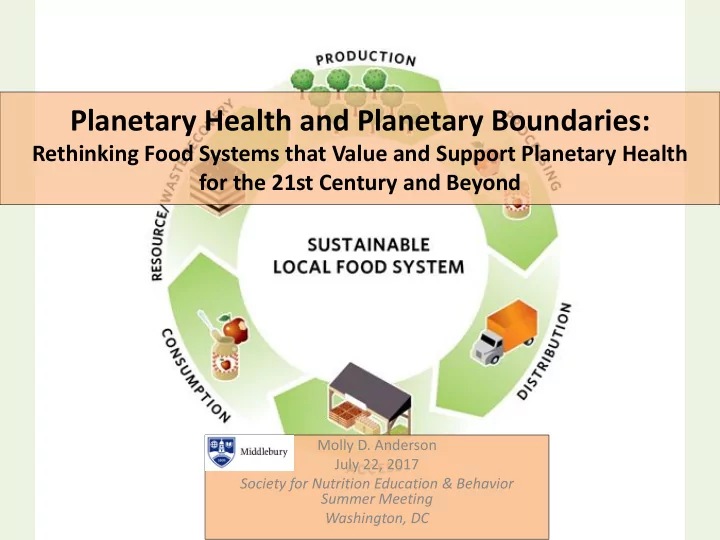

Planetary Health and Planetary Boundaries: Rethinking Food Systems that Value and Support Planetary Health for the 21st Century and Beyond Molly D. Anderson July 22, 2017 Society for Nutrition Education & Behavior Summer Meeting Washington, DC
Depicting food systems – for what purpose?
Depicting food systems – for what purpose?
Depicting food systems – for what purpose?
Purposes of systems analysis Better understand issues and problems stemming from the interaction of system components and their key drivers Think logically and comprehensively about behavior over time of those components; reason about the structure and function of the system Share this understanding with others Make predictions by modeling interactions Test assumptions and theories of change Help to figure out intervention points Develop visions of alternatives, and imagine pathways to achieve them
Identifying leverage points Source : Meadows, Donella H. 2008. Thinking in Systems. A Primer. White River Junction, VT: Chelsea Green Publishing.
Identifying leverage points Health Effects State of Cultural State of Paradigms Social Human Health Effects State of & Wellbeing Community Co-Effects Environmental Effects State of Ecosystem Source : Dyball, Robert & Barry Newell. 2015. Understanding Human Ecology: A Systems Approach to Sustainability. Earthscan.
Ex. 1: Using systems analysis – Antibiotics in livestock Relationships of sub-therapeutic antibiotic use (STA), antimicrobial resistance (AMR) and cultural paradigms Industrialized Prevalence of agriculture is Prevalence of diet-related R positive, necessary, AMR in humans disease R “scientific” Extent of Political power of STA use in Big Ag/Big Food livestock Environmental Prevalence of impacts of AMR bacteria in industrialized the environment agriculture Cultural paradigm
Systems analysis in antibiotics example Better understand issues and problems stemming from the interaction of system components and their key drivers Think logically and comprehensively about behavior over time of components in the system Share this understanding with others Make predictions by modeling interactions Test assumptions and theories of change Help to figure out intervention points Develop visions of alternatives, and imagine pathways to achieve them
Ex. 2: Using systems analysis - New England Food Vision Grow 50% of the food we consume in New England by 2060 Achieve the right to food for all Create racial equity and food justice Develop thriving communities Achieve sustainable fishing and farming Keep at least 70% forest cover What this will take: Triple the amount of current farmland (6 million acres) by returning to a similar landscape pattern as New England had in the mid-1900s
How can we reach the New England Food Vision? Source: Christoph Hinske, Institute for Strategic Clarity
How can we reach the New England Food Vision?
How can we reach the New England Food Vision?
Systems analysis in the New England Food Vision Better understand issues and problems stemming from the interaction of system components Think logically and comprehensively about behavior over time of components in the system Share this understanding with others Make predictions by modeling interactions Test assumptions and theories of change Help to figure out intervention points Develop visions of alternatives, and imagine pathways to achieve them
How can we reach the New England Food Vision?
Recommend
More recommend